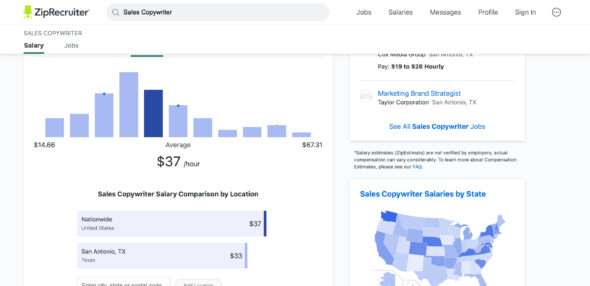Too many creative writers neglect the basics of sales copywriting when writing for retail brands. Retail clients have different needs. Knowing how to craft a romantic, awe-inspiring poem won’t mean much to someone who needs a straightforward yet sales-y product description.
Before applying for copywriting jobs online, ensure you know how to write for retail. Understand the nuances and apply them to your writing. You’ll have a better shot at landing high-paying roles if you can produce the content businesses need.
Retail Copywriting vs. Creative Writing: 7 Differences to Consider
Here are some things to consider if you’re a creative writer who is exploring retail copywriting for the first time.
1. Prioritize Brevity and Clarity Over Flowery Words
Good sales copies should help consumers make informed decisions, not “impress” them with superfluous, flowery words. Focus on making clear, concise statements. Instead of setting the scene with lengthy prose, dive right into the meat of the copy by addressing your reader’s pain points.
Let’s say you’re describing a gaming chair. Creative writers might analyze this piece of furniture on a metaphysical level and write an abstract life metaphor. They might say it symbolizes comfort and refuge amidst daily struggles.
However, if you’re writing for retail, you should eliminate superfluous terms and romanticized analogies. Just lay down the facts for consumers. Compile your product specifications, organize them in a neat table, and then explain how readers can benefit from these items.
2. Never Make Baseless Claims or Opinions
Many creatives express themselves through their writing. They use poems, stories, and journals as creative outlets where they can dump their unfiltered thoughts and emotions. In these pieces, you can share whatever opinion you want.
However, that’s not the case with professional copywriting and content writing. You must avoid making baseless claims and opinions—always back your pieces with data and figures. Hasty, unjust statements could put you in serious legal trouble.
Jim Pendergast, the senior vice president at altLINE Sobanco, also advises retail marketers to regulate their sales copies. He says, “Although marketing has some leeway for exaggerations, you should know your limits. Generic statements about how you have the best [product] in the world are fine. However, outright lies and misleading claims, e.g., claiming to cure diseases, fabricating data, and omitting crucial disclaimers, violates fair trade guidelines.”
Warning: Freedom of speech doesn’t absolve you of responsibility. Backlash is a natural response to spiteful, hateful comments aimed toward specific groups or individuals. Practice responsible expression when tackling differing viewpoints.
3. Creative and B2B Writers Follow Different Rates
Creative writers and B2B copywriters follow different pay structures. Since writers spend more time producing creative literature, like poems, novels, and short stories, they rarely charge hourly wages. After all, publishing a book could take anywhere from weeks to years. They make money by selling finished pieces or collecting royalties—only their editors, proofreaders, and agents get hourly wages.
Meanwhile, sales copywriters often charge per hour or word. The rates vary based on skill, demand, and experience, although the average is $37 per hour, according to ZipRecruiter.

Jerry Han, CMO at PrizeRebel, reminds writers to set custom rates instead of blindly copying others. He says, “You’re free to set your own rates. Research the average pay in your industry and gauge your level of expertise before deciding on your expected compensation range. Also, make sure you have your portfolio when negotiating freelance rates.”
4. Incorporate SEO Tactics Into Your Writing
Creative pieces rarely, if ever at all, require SEO. The goal is to create a literary masterpiece that expresses your abstract thoughts and encapsulates your writing style. You don’t have to use keywords or target phrases. Selling and writing creative pieces are different professions that require varying strategies.
On the other hand, sales copies and product descriptions thrive on SEO. By integrating top-searched keywords and phrases into your geo-optimized copies, you’re directing them toward the right market. Remember: a broad, generic audience merely drives up your ad spend.
Brooke Webber, the head of marketing at Ninja Patches, encourages retail copywriters to study different SEO tactics. She says, “There is no one-size-fits-all SEO tactic. Your approach should vary based on the platform you’re using. Let’s compare TikTok and Google AdSense. While SEO keywords might work well with Google Ads, they won’t help you go viral on TikTok. Likewise, the use of trending sounds and hashtags boosts visibility on TikTok but yields negligible results on Google AdSense.”
5. Give Concrete Details of Your Product or Service
Remove vague, ambiguous language from your sales copies. In creative literature, they build anticipation and set the scene, but in copywriting, they’ll just confuse readers. Note that consumers have limited attention spans. They might skip your ads and listings if you beat around the bush with flowery phrases and irrelevant analogies.

Let’s say you’re selling classic timepieces. The value of a vintage Rolex strays from its SRP, so you must justify its price tag right from the get-go. Otherwise, you’ll lose your prospect. Instead of creating a lengthy explainer on the history of Rolex, focus on why your specific listing costs that much, when it was first acquired, and how the reader will benefit from owning it.
6. Replace Your Conclusion With CTA Phrases
Creative writing and retail copywriting have different goals. The former usually serves as a creative outlet or art form, while the latter primarily exists to sell something. Keep that in mind while writing. An awe-inspiring poem could move readers, but it might not convince them to purchase whatever you’re selling.

Tom Golubovich, the head of marketing & media relations at Ninja Transfers, encourages retail copywriters to master CTA phrases. He says, “Guide readers throughout your piece with CTA phrases—subtly tell what you want them to do. Let’s say you’re selling an online course. You could sprinkle phrases hinting readers to subscribe to your email, leave their contact details, or download the first part of your program.”
7. Review Industry-Relevant Legal Guidelines
Retail copywriters have to abide by more legal guidelines than creative writers do. Let’s say you’re writing for a U.S. law firm. Although lawyers are allowed to advertise their services, they must follow the regulations set by the American Bar Association (ABA).
Basically, lawyers can’t guarantee outcomes or propose manipulative solutions. They can’t even exaggerate their expertise. Legal practitioners could get penalized for calling themselves “specialists” if they aren’t certified “specialists” in their fields.
Robert Kaskel, the Chief People Officer at Checkr, advises retail copywriters to consult their client’s legal team beforehand. He says, “As a writer, you’re not expected to understand the legal scope and limitations in every industry. However, ignorance of the law excuses no one. To prevent legal mishaps, consider talking to your client’s legal department before writing your sales copies. That way, you’ll know what practices to avoid.”
Practice Both Creative Writing and Retail Copywriting
Understanding the differences between creative writing and retail copywriting is one thing, but putting them into practice is another. Try integrating them into your copies. Strive to produce engaging, attention-grabbing pieces that align with your target metrics. Remember: write for your readers, not yourself.
Also, you don’t have to decide between creative writing and retail copywriting. Try both writing styles—see which one you prefer. Regularly visit online job boards like Freelance Writing Jobs, look for paid gigs with these niches, and submit your applications. It’s an efficient way to improve your writing while making a living.

